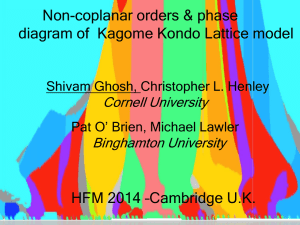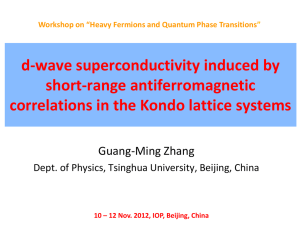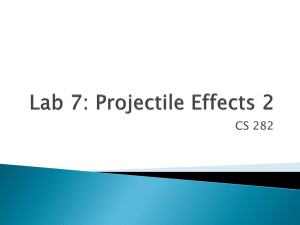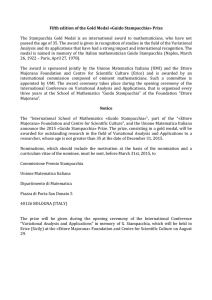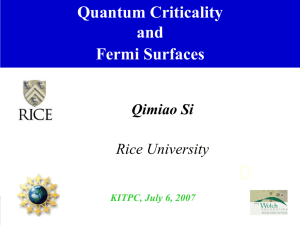Topological Kondo effect
advertisement
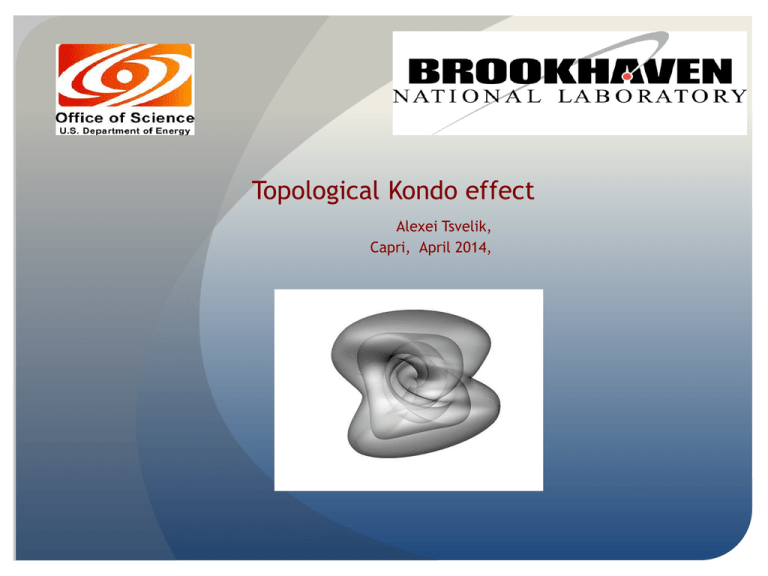
Topological Kondo effect
Alexei Tsvelik,
Capri, April 2014,
Topological Kondo effect occurs when bulk quasiparticles scatter
on composite spin nonlocally encoded by Majorana fermions
located at different space points.
Simplest example: spin S=1/2 can be made of 3
Majorana zero energy modes:
i abc
S b c ,
2
r2
S 3/4.
a
b , c bc ,
a a,,
How to manufacture a Majorana fermion?
c c
It looks similar to Bogolyubov quasiparticle, but
electrons have spin!
Semiconducting wire with a strong spin-orbit interaction in a
transverse magnetic field on top of a superconductor (Sau,
Lutchyn, Tewari, Das Sarma, 2010):
1 2
H dx x i yx B x y h.c.
2m
With a proper choice of parameters Majorana zero modes emerge
at the boundary.
Majorana-Coulomb box: semiconducting wires with strong spinorbital interaction on top of a mesoscopic superconducting
island.
Red dots: E=0
Majorana
modes
located at
the ends of
the wires.
a , b ab ,
hij – inter-wire
tunneling
Derivation of the Kondo
model
Beri,Cooper
2012
2
H (k)C j (k)C j (k) H tunn E c i q /2,
j,k
H tunn e i / 2 t ij iC j (x j ) H.c.
j
Ec is the charging energy of the island, is its phase,
subscript j labels the wires.
By Schrieffer-Wolf transformation one obtains the low energy Kondo
model:
H (k)C j (k)C j (k) Jij i j (CiC j C j Ci ) x0 ,
j,k
J ~ t 2 / Ec .
Where else to get Majoranas? Transverse field Ising
chains. The model of Y-junction
3
H H pIs J121x 12x 1 J 232x 13x 1 J131x 13x 1,
p 1
N
H Is J x j x j 1 h z ( j) .
j 1
I assume that Jpq << J and
J=h: the chains are critical and one
can use a continuous description.
Ising model on a star graph: Jordan-Wigner
transformation (Crampe, Trombettoni 2012, Tsvelik
2013).
j 1
p ( j) p c p ( j)expi c p (k)c p (k),
k 1
zp ( j) c p ( j)c p ( j) 1/2,
p
c
, q 2 pq ,
p
( j),c q (k) pq jk ,
{ ,c} 0.
p,q label the chains.
The difference with the conventional version is the presence of the Klein factors.
p are zero energy
Majorana fermions.
The fermionic version of the Ising model emerges
after Jordan-Wigner transformation.
M
H J c p ( j 1) c p ( j 1) c p ( j) c p ( j) hcp ( j)c p ( j)
p 1 j 1
J
p q
pq
p q c p (1) c p (1)c q (1) c q (1).
The boundary spins are
xp (1) p c p (1) c p (1) .
Single Ising chain with a free boundary. The
continuous description (Ghosal, Zamolodchikov).
( j) c ( j) c( j),
( j) ic ( j) c( j),
R,L (x ja) ( j) ( j)/ 2a.
L
L
0
1
1
1
dx R ivx R L ivx L im R L ,
2
2
2
v Ja,
m J h.
R (0) L (0)
R ,L are real (Majorana) fermionic fields propagating in the bulk.
The boundary condition corresponds to the free boundary spin.
For critical chains (m=0), one can introduce chiral fermions: x) = R
(x)qx)+L (x)qx) and extend x integration over entire axis:
M
1
H
2 p 1
dx iv J
p
x
pq
p q q (0) p (0),
p,q
x , y
a
p
b
(x y),
p
, q
pq
.
Jpq = q p are O(M)1 Kac-Moody currents.
Thus the junction of M critical Ising chains is described by the new
type Kondo model. For M=3 it equivalent to 2-channel Kondo model
in the Majorana fermion formulation of Ioffe et al. (1994).
Both the model with the Majorana-Coulomb box and
the model of Ising star graph are exactly solvable.
Star graph model has a singlet ground state for M even,
and Quantum critical point for M odd (Tsvelik, 2013,2014).
The Majorana-Coulomb box model is Quantum Critical
(Altland et.al, 2013).
Solution: Bethe ansatz, bosonization,
boundary Conformal Field Theory.
Back to the Majorana-Coulomb box. Non-Abelian
bosonization.
In Kondo models the bulk can be represented by 1D
chiral fermions with linear spectrum.
We have the following remarkable identities:
p
dx
2
(2)
) (a )
i C Cq C C p i (a
p q J pq ,
q
iC j x C j
a 1
2
M
(2)
dx : J (2)
J
pq pq :
1
2
dx
Only the current operator interacts with
the impurity “spin”
2
(x ) 2
i p q
This allows one to identify the critical point as O2(M) WZNW
boundary CFT and also to conjecture the Bethe ansatz.
The most interesting results are for the Majorana-Coulomb box
model with M leads.
At energies << TK ~Ecexp[-2/M2J] the model is
quantum critical. The universality class is O2(M) WessZumino-Novikov-Witten theory with a boundary c=M-1.
There is a finite entropy in the ground state
S(0) = ln dM, dM = (M)1/2 (M odd), (M/2)1/2 (M – even).
The most unusual feature is non-trivial M-point
correlation functions (the next page).
Universal conductance Gjk=(e2/h)[jk -1/M]
Coulomb-Majorana box model with M=3 leads.
Abelian bosonization: the Gaussian model of 2 fields 1,2.
At the QCP:
A ddxxa xa ia ,
S cos 8 /31(0) ,
z
z
a 1,2.
S cos 2 /31(0) e
i 2 2 (0)
are cocycles. Thus at low energies the “spin” components
become primary fields of the boundary CFT with
dimension 1/3.
M=3 problem is equivalent to 4-channel S=1/2 Kondo model.
Here the thermodynamics and the response
functions are the most singular.
For M>3 the singularities are weaker.
There are non-trivial M-point functions of “spin”
components. The “spin” operators are defined as
tunneling ones:
S jk i j k
Non-trivial 3-point function for M=3
For M=3 “spin” operators are components of S=1/2: Sa =iabcbc
The long time
) a
TS 1 S b 2 S c 3
asymptotic:
Response to h cos(wt) S3:
) 1 2
TS (t1)S (t2 ) ~ hcos[w (t1 t2 )]F[w (t1 t2 )],
F(x) x 1/6[Y1/6 (x) J1/6 (x)].
abc
,
Tk (1213 23 )1/ 3
Ising junctions.
What is the “spin” in this case? It is made of zero modes
of different chains:
i
p
S pqt q t ,
2
But the zero mode operators are nonlocal in Ising spins and one
cannot probe it with any local “magnetic” field.
The nonlocality preserves the critical point,
but makes it difficult
to observe.
Thing-in-itself
(almost).
Although for critical Ising chains the “spin” is not
directly observable, one can use the relevant operator
h n n+1 as a formal device to generate a crossover
between M and M-2.
To understand the difference between even and odd M,
add the relevant operator h n n+1which drives the
system from M to M-2. The minimal even M is 2 (Fermi
liquid), the minimal odd is 1 (single boundary
Majorana).
Observables: energy levels and thermodynamics
are as for the Kondo model:
C/T ~ln(Tkondo /T) , but
the correlation functions are different.
The star junction of M critical Ising chains.
The most interesting case is M=3.
There is nonzero ground state entropy S(0) = ½ ln2 (Wiegmann and
Tsvelik, 1984).
The effective action for energies < Tkondo is (Ioffe et. al. 1994)
1
1
L g1(0) 2 (0) 3 (0) p ivx p dx
2
2
*
For equal couplings Tkondo ~ Jexp(- /G).
One local Majorana zero mode remains unquenched. Its
relation to the bare Majoranas is complicated.
Conclusions for the Ising model
Star-junction of three critical Ising chains is an active
element where the boundary states undergo a
renormalization.
Existence of these boundary degrees of freedom comes
from topology – in the given case just from the fact that
the chains have ends.
The M=3 case realizes 2-channel Kondo model. For all
odd M there is a non-Fermi liquid Quantum Critical
point. In the process the boundary “spin” is quenched,
but not completely.
Conclusions for the Majorana-Coulomb box model.
The model is always quantum critical.
There are multiple possibilities for observing the critical
properties: one can measure the conductance, a
response to external gate potentials etc.
For M=3 there is an interesting “spin” response related
to existence of nontrivial 3-point correlation function of
the “spins”.
Main conclusion
Models of topological Kondo effect provide natural
settings for Quantum Critical Points.
Despite the screening of the local degrees of freedom
by the gapless bulk excitations the non-Abelian nature
of the “spins” reveals itself in the ground state in nontrivial multi-point correlation functions.
Two-channel Kondo model of electrons in the Majorana
representation. The equivalency is derived by non-Abelian
bosonization.
H i
dx G (0) S (0),
j
j
p
x
j
j 1,2; 1,2
p
p
j
j 1,2
2
1
1
1
2
i dx j dx x dxaxa dxax a ,
2
2 a 1,2,3
2 a 1,2,3
j 1,2; 1,2
j x
i pqt
p
j j 2 q t .
j 1,2
The Hamiltonian of SU(2)xSU(2)
can be written as
a sum H of free boson field and
Dirac fermions
These fermionic bilinears have
the same
commutation relations.
two
triads of Majorana fermions
,
The Y-junction describes just the spin) sector of the Kondo Hamiltonian,
but this sector contains all interactions.
So, what to measure?
Energy levels. Ising chains can be made of Josephson junctions (M.
Gershenson).
Correlation functions from different chains, for instance:
w 2 (w ) ~ J12 ln (J /w )
z
1
z
2
In the 1st order of perturbation theory.
Topological Kondo effect in Coulomb-Majorana box: SO2 (M)
Kondo model.
g
H (k) (k) j (k)
N
k, j
j
j,p;k,k'
j
(k) p (k') (k) j (k') j p
p
ih jp j p .
t2
g~
Ec
Spinless fermions in the
leads.
Supersymmetry of 2-channel Kondo model.
H Q ,
2
Q
dx
1 2 3
Ga a 0Sa .
Another idea from particle theory. Is it of any use?
Happy Anniversary!
An early image of Paul Wiegmann from Louvre (Fra
Angelico):
Majorana fermions in condensed matter physics.
As collective excitations –
Long history
2D Ising model = free
Majorana fermions
(Onsager 1945,
Kaufman 1949, Baruch, Tracy,
McCoy, 1976, Schroer,
Truong 1978).
1D Quantum Ising model –
Jordan-Wigner
transformation.
80-ties: 2-channel Kondo
model (Wiegmann,
Tsvelik), S=1 magnets
(Takhtadjan, Babujan), SU2
(2) Wess-Zumino model
(Fateev, Zamolodchikov).
90-ties: spin ladders
(Nersesyan, Tsvelik).
In all these models Majoranas
emerge as collective
excitations.
As
quasiparticles:
the history
starts at 1987
Volovik,
Salomaa.
Both paths meet
at defects where
propagating
particles become
zero modes.
